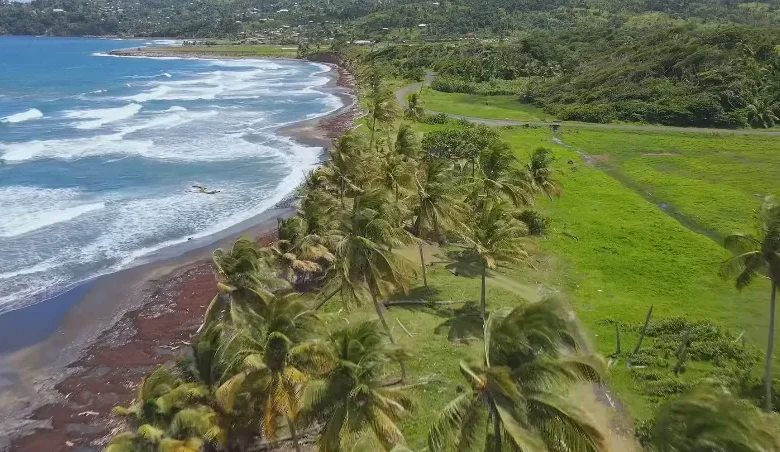Black Sand Beaches of Dominica

Dominica’s black sand beaches are the volcanic fingerprint of an island forged by fire. These striking coastlines of finely ground basalt and volcanic rock wrap the island’s shores with unique natural beauty and geological significance. Unlike traditional white-sand beaches in the Caribbean, Dominica’s darker beaches carry a raw, wild aesthetic that perfectly complements the island’s rugged terrain, cascading rivers, and towering peaks.
Each black sand beach is distinct—some tucked into secluded bays, others framed by rivers and fishing villages. They are not just geographical features but places of livelihood, ritual, and quiet refuge.
The North and Northeast: Seclusion and Dramatic Backdrops
The northeastern region of Dominica offers some of the most untouched and photogenic black sand beaches. These are often bordered by cliffs, coconut groves, or flowing rivers that empty into the Atlantic.
Batibou Beach, located in Hampstead, is one of the island’s most celebrated stretches of black sand. Nestled in Batibou Bay, this beach offers towering palm trees, natural shade, and dramatic Atlantic views. Adjacent to it lies Number One Beach, a similarly striking but less frequented site, known for its cinematic appearance in Pirates of the Caribbean: Dead Man’s Chest Filming in Dominica.
A short walk away is Hampstead Beach, cradled by the Hampstead River to the west and the Red Rocks to the east. This beach sits safely within Hampstead Bay, creating a peaceful refuge despite the Atlantic’s strong currents.
To the north, the small community of Capuchin faces rugged cliffs and steep beach landings. While not suited for swimming, the views at Capucin Cape and nearby coves are unmatched in their wild beauty.
West Coast Beaches: Calm Waters and Community Life
Dominica’s Caribbean coastline is gentler, and many of its black sand beaches double as community spaces, fishing zones, and cultural gathering sites.
In Portsmouth, the black sand shore near Bay Street and the Portsmouth Fisheries Complex serves as both a launch site for fishing boats and a scenic edge to the Portsmouth Market. This stretch is also ideal for observing the maritime activity around Prince Rupert Bay, Dominica’s largest natural harbour.
Just south of Portsmouth, Toucari offers calm waters ideal for kayaking and swimming. Its beach is small, but framed by coral reefs and local fishing boats.
Further down the coast lies Colihaut and Dublanc, whose black sand beaches are steep but tranquil. Community events and fish festivals are often held here, celebrating the sea’s bounty and linking tradition to daily life.
Soufrière and Scotts Head sit at the southern tip of the island, within the Soufrière Scotts Head Marine Reserve. Their beaches reflect volcanic origins, and the views of the Atlantic Ocean merging with the Caribbean Sea from the Scotts Head Peninsula are unforgettable.
Central and South: Historic Connections and Tourism Growth
Close to the capital, several black sand beaches are seeing renewed interest due to nearby accommodations and their access to diving and whale-watching excursions.
Newtown, along the Roseau fringe, has long been a traditional fishing community. The beach here, facing the Caribbean Sea, is a working coastline with boats, nets, and marine traffic, supported by the nearby Newtown Fisheries Complex and associations like the Newtown Fisheries Cooperative.
Southward, Loubiere and Castle Comfort host dive shops and guesthouses that line small black sand beaches used for launching underwater expeditions. These sites are frequented by those heading out for Whale Watching in Dominica and scuba diving tours.
Ecology, Preservation, and Community Use
Dominica’s black sand beaches are more than visual landmarks—they are crucial to the island’s ecological health and coastal resilience. Many of them serve as nesting grounds for Leatherback Turtles and Hawksbill Turtles, especially during the breeding season. Conservation groups and local communities monitor these nesting sites, ensuring that tourism remains low-impact.
The sand composition and adjacent vegetation also help buffer coastal erosion, especially important in areas prone to storm surges and hurricanes. Some beaches, particularly along the Atlantic side, are used by farmers to access river mouths and estuaries for irrigation or fish traps.
Efforts to maintain cleanliness and reduce plastic waste have grown in recent years, supported by NGOs, schools, and government initiatives. Beaches near villages like Calibishie, Rosalie, and La Plaine now feature signage about turtle nesting and shoreline protection.




